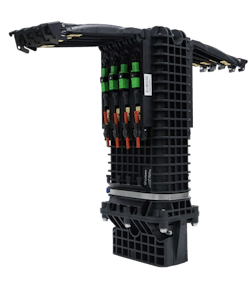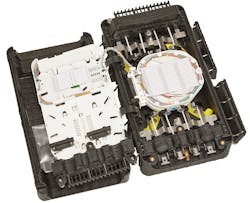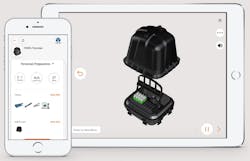What’s New in Optical Networking Technology?
Optical networking technology continues to evolve to meet the insatiable bandwidth demand driven by new advances and new consumer and business demands.
So, what’s new in optical networking? We asked some technology companies to describe their recent innovations and how they can solve problems for your network.
Apex X-1 Sealed Splice Closure from AFL
AFL says: “The Apex X-1 is a new addition to AFL’s Apex family of sealed splice closures. It is a transformative solution in the telecommunications infrastructure sector, revolutionizing the industry’s approach in fiber deployment. As the most compact sealed dome splice closure in its class, this latest design balances size optimization with exceptional performance, supporting up to 144 single fusion, 432 mass fusion with standard ribbon, or 864 mass fusion with “rollable ribbon” fiber types such as AFL’s SpiderWeb Ribbon® (SWR®). “
Decentralized Split Plug-and-Play Architecture from Go!Foton
Go!Foton says: “Go!Foton’s Decentralized Split Plug-and-Play Architecture solution provides a more cost and labor-efficient way to design your network. The approach utilizes single-stage splitters, like centralized architecture, but distributes those splitters throughout the network in several key locations. Connectorized drop terminal stubs pull back to each splitter location eliminating the need for splicing.
This plug-and-play approach helps speed deployment and create more flexibility for the network as it continues to evolve. In addition to minimized splicing, the cable size used is reduced from the typical 144F-288F cable used in a centralized split architecture to just 12F-48F which significantly reduces material cost as well.
Go!Foton’s PEACOC® Multiport Mid-span Terminal (MMT) houses up to three 1x32 splitters to feed up to 96 homes. Then, Go!Foton’s PEACOC® Clamshell Hardened Terminal (CHT) plugs back into the MMT for rapid, splice-free connectivity. Each CHT provides service for up to eight homes and enables hardened fiber terminal functionality with the use of proprietary connectors. Benefits of this network design include easier documentation, flexible split ratios, reduced installation costs, and flexibility in drop cable sourcing.”
Photonic Integrated Circuit (PIC)-Based Optical Interconnect from Infinera
Infinera says: “Generative AI relies on high-performance graphics processing units (GPUs), which consume significantly more power than traditional servers based on central processing units (CPUs). A single ChatGPT query uses 10 times the power of a standard browser search. Goldman Sachs Research estimates that data center power demand will increase by 160% by 2030, driven by GPU deployments in data centers and the growing use of AI by enterprises and consumers. In addition to requiring more power for processors, these new AI data centers will also generate a massive amount of data that will need to be transported between AI racks and clusters.
To help network operators manage rising power and bandwidth demands, Infinera has developed a pioneering solution for short-reach intra-data center connectivity. Our unique monolithic, massively parallel indium phosphide (InP) photonic integrated circuit (PIC)-based optical interconnect solution, ICE-D, can transmit 1.6 terabits of bandwidth per second while consuming up to 70% less power than alternative solutions. ICE-D is a flexible, highly integrated single-chip technology that can be incorporated into various optical solutions, including fully retimed, half retimed, and linear pluggable optics. ICE-D will be showcased at this year’s OFC50 conference in San Francisco from March 30 to April 3.”
BILT App from Clearfield
Clearfield says: “Fiber technicians often face challenges in the field that require quick, practical solutions. Traditionally, resolving these issues might mean returning to the office, delaying progress, or waiting for support. The BILT® mobile app eliminates these inefficiencies by providing real-time, 3D interactive guides designed to streamline setup and training processes. Accessible anywhere, even without internet connectivity, the app delivers step-by-step manuals enriched with audio, text, and images, enabling technicians to troubleshoot and complete tasks without leaving the site.
Clearfield has partnered with BILT to offer the industry’s first 3D interactive fiber installation guides on the app, created with the needs of today’s workforce in mind. As the fiber technician demographic evolves, with many experienced technicians retiring and a new generation of installers stepping in, resources like the BILT app are crucial to bridge the skills gap. Its intuitive, user-friendly design caters to how younger generations learn and consume information—quickly, visually, and interactively.
By equipping technicians with tools that improve on-site efficiency, reduce errors, and eliminate unnecessary trips back to the office, the BILT app maximizes time in the field and ensures fiber networks can be deployed faster and more effectively. Clearfield remains committed to creating innovative resources and tools that support the continued modernization of the fiber workforce.”






